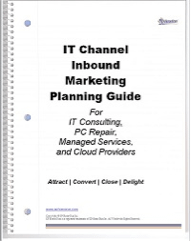
I recently did a podcast with Joshua Feinberg, an interesting guy and certified HubSpot partner, whose company, SPHomeRun, helps IT service providers (Cloud, MSP, Consulting, Repair, etc.) with inbound marketing.
One of the subjects we covered was the value of talking to sales reps — people who actually talk to customers — when planning a video project. Even though, as Josh and many others point out, 60% of the typical B2B sales cycle over before a potential client even reaches out to any vendor’s sales department, sales people know the kinds of questions good prospects ask. That’s the kind of question inbound marketing — and your video — needs to answer.
Inspired by Josh’s many checklists, here’s a checklist of five things you should be asking of sales (and marketing and sales engineering). Not that any of these are “tough” questions. They are intended to elicit answers that will get you thinking about different ways to approach the video. In particular, what will be the very first thing the audience sees and hears?
1. Who are we talking to?
Your video is standing in for the salesperson, so you want to know who it is in a targeted organization that the sales person usually talks to. And who does that person talk to? What you’re trying to figure out here is, who is on the buying team? and who is likely to visit your website? Then you can design in content that reaches out to as many job roles on the team as is practical without watering down the main messages.
2. What do potential customers already think about your solution?
Count on it — they know something. They’ve heard of you, or they’ve read something about you. You can glean some of what prospects know by reviewing successful keywords. Presumably, your video should address things people clicked on watch it. Salespeople and other subject matter experts should be able to tell you the kinds of preconceptions people arrive with. A video that helps argue people out of preconceptions will stick in the mind and is likely to be shared.
3. What are the major pain points your solution addresses? What is being done now to address the pain? Why isn’t it working?
The status quo can easily gain the upper hand where there is disagreement and hesitation. Because it’s fast and allusive, it can quickly remind people that maintaining the status quo could be a very bad idea.
4. Who else is addressing these pain points? What are they claiming for their solution?
This may sound obvious. Of course, you’re going to take competitors’ messaging into account. But salespeople often have the most succinct and pungent ways to dismiss or rebut competitors’ claims. These counter-arguments may not be entirely fair, but they are likely to get lodged in a viewer’s mind anyway.
5. What is it about your solution makes customers especially happy?
You have some feature or benefit that competitors lack and customers have been known to rave about. Find out what it is and make sure it’s in the video. If it actually makes someone happy, people will want to hear about it.




